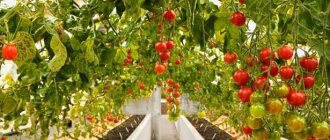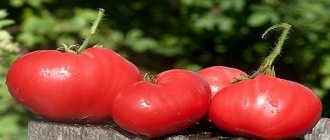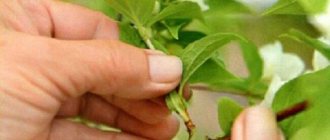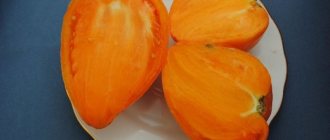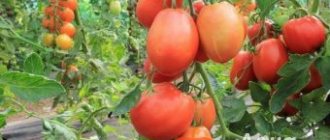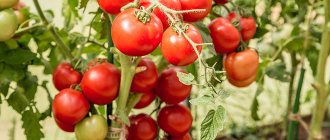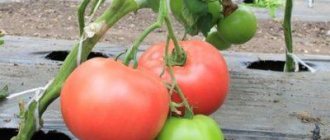Modern tomato hybrids are very popular among gardeners because they produce rich harvests and are resistant to temperature changes and diseases. One of these varieties is Ivanych F1, bred by Siberian breeders. If you follow all the necessary instructions and growing rules, the result will not take long to arrive.
The article provides all the necessary information about the hybrid, which will be useful to the gardener: characteristics, features of cultivation and agricultural technology, reviews from summer residents.
Description of the variety
Hybrid Ivanych belongs to the mid-early crops. Tomatoes ripen 90-95 days after the first shoots appear. The bushes are low, can reach a height of 70 cm.
Distinctive features
The hybrid is characterized by high yield, resistance to many diseases and parasites, and excellent taste.
A distinctive feature of the Ivanych hybrid is its sweet taste with slight sourness and the bright pink color that the fruits acquire during the ripening process.
Fruit characteristics, yield
The fruits grow in clusters of 5 pieces. Ripe tomatoes have a pink-scarlet color, reach a weight of 200 g. They have thick, glossy skin and juicy pulp. It is distinguished by high productivity if all rules of agricultural technology are observed - up to 18 kg per 1 sq. m. Some gardeners manage to collect 25 kg from 1 sq. m. m.
Important . Ivanych F1 is picky about soil composition. The application of fertilizing and fertilizers when growing them is mandatory.
Characteristics
Among the main advantages of the variety:
- excellent taste of the fruit;
- high productivity;
- cold resistance;
- good seed germination;
- resistance to major nightshade diseases;
- bushes do not require shaping or tying up.
Among the features of the variety is its demandingness regarding soil nutrition . Tomatoes respond very well to fertilizers, increasing the mass of fruits and increasing the number of ovaries. Another disadvantage, characteristic of all hybrids, is the inability to collect seeds yourself, from ripened fruits.
You can compare the yield of this variety with others in the table below:
| Variety name | Productivity |
| Ivanovich | 12-18 kg per sq.m |
| Nastenka | 10-12 kg per square meter |
| Bella Rosa | 5-7 kg per sq.m |
| Banana red | 3 kg per bush |
| Gulliver | 7 kg per bush |
| Lady Shady | 7.5 kg per square meter |
| Pink Lady | 25 kg per square meter |
| Honey Heart | 8.5 kg per bush |
| Fat Jack | 5-6 kg per bush |
| Broody | 10-11 kg per square meter |
How to grow seedlings
Seeds are sown for seedlings in early spring. If you plan to grow them in a greenhouse, the planting date will come 10 days earlier.
Seed preparation
To get a good harvest you will need quality seeds. Testing for germination using a saline solution will reveal empty seeds that will not grow into anything.
If planting material has been stored in a cool place, it must be warmed up several weeks before planting. The storage temperature should be increased gradually, starting from room temperature.
Then you need to prepare the seeds for planting. To do this, they are soaked in a growth stimulator for 10-12 hours. For this purpose, you can use a solution of potassium permanganate. This will disinfect the planting material and accelerate growth. After soaking, the seeds are thoroughly washed with water.
Important . Tap water is not suitable for washing seeds. It negatively affects the yield and other properties of tomatoes. It is better to use rain or filtered water.
To improve the effect, you can treat the seeds with a nutrient. Potato juice or aloe juice are ideal for this - they will increase yield and germination.
Container and soil
For seedlings, deep containers that need to be tightly filled with soil are suitable. The soil should be light and contain peat, sand and turf soil. The soil should have a normal acidity level.
Important . Before planting, the soil is checked for the presence of weeds, pests and larvae. They can cause dangerous diseases and harm plants. To disinfect the soil, heat it in the oven.
You can buy soil for tomatoes in advance, or you can make it yourself. To do this you will need 3 kg of peat per 1 kg of turf. Sand and ash can be added to this mixture.
To make the soil looser and lighter, as well as saturate it with air, you need to sift it. To increase productivity, add 15 g of lime for every kilogram of soil.
Sowing
The finished seeds are planted in the soil to a depth of 2 cm. Then the soil is sprayed with water at room temperature and covered with film. After this, the container is placed in a warm place until the first shoots appear.
Growing and care
When the shoots have appeared, the container is placed in the brightest place in the house, for example, on a windowsill. It is advisable that the window faces the sunny side.
If the weather is cloudy or there is not enough daylight, use a fluorescent lamp. Plants need to be watered once every 5 days. When the leaves appear, the seedlings are fed with liquid fertilizer.
Features of cultivation
Selection of seed
High-quality seeds are those that are heavy in weight and large enough in size, since which seeds contain nutrients, therefore, healthy and strong tomato bushes can grow from them. In order to quickly and easily select good seeds, you need to prepare a saline solution. To do this, take one spoon of salt and dissolve it in one glass of water, then pour in the seeds, mix well and leave for about 10 minutes. The seeds that are suitable for growing will sink to the bottom, and those that are on top need to be discarded.
Warming up the seed
If the seeds were stored in any cool place (such as a refrigerator, cellar or warehouse where the temperature is low), they must be warmed up a month before sowing. It is very important to increase the temperature gradually, starting from room temperature (18-20 degrees) to 80 degrees. If seed preparation is done at home, then the seeds can be heated on a radiator; this will only take a few days. But the hybrid does not require mandatory warming up.
Pre-planting treatment
It is imperative to carry out disinfection, this is necessary so that diseases that live on the surface of the seeds do not infect the emerging seedlings. People call this action “bullying.” There are two processing methods:
- First way. You need to take a one percent solution of potassium permanganate and place the seeds, wrapped in gauze, for half an hour.
- Second way. A 2-3 percent peroxide solution is heated to 40-50 degrees and seeds wrapped in gauze are dipped into it for 8-10 minutes.
After any of the above procedures, the seeds are washed with running water.
Important! Do not use tap water. Chlorinated water negatively affects seeds, their germination and yield. It is better to use filtered or rainwater.
They are then treated with any nutrient. Among folk remedies, aloe or potato juice is suitable as a nutrient. You can also use industrial preparations such as: “Immunocytophyte”, “Vartan” and others. This addition increases tomato yield.
Soak
Before germinating the seeds, they must be soaked. To do this, you need to make a small bag of gauze, place the seeds in it and lower it into warm (23-27 degrees) water. It is very important to carry out this action for 10-12 hours and no more. The water should be changed every 3 hours.
Germination
In order to get seedlings and, accordingly, a harvest as quickly as possible, it is better to germinate tomato seeds before planting. To do this correctly, you need to take a tray or saucer and put the seeds in gauze (or any other natural fabric). Be sure to spray with water to keep the fabric sufficiently damp. Seeds must be placed in a place where the temperature is above 20 degrees. It is very important to monitor the moisture content of the fabric; it should not dry out, but it should not be wet either.
Hardening
It's no secret that tomatoes are very heat-loving, therefore, in order to help the plants gain resistance to conditions that cannot be called favorable, the seeds must be hardened. This is done at the initial stage, as soon as they have sprouted. It needs to be hardened by sudden changes in temperature. As soon as the first seed shoots appear, place them in the refrigerator overnight. The temperature should be 2-3 degrees, but during the day we move the seeds to where the temperature reaches 20 degrees. This action must be repeated at least three times.
Breeders confirm that this method of hardening makes the tomato resistant to sudden temperature changes, the fruits on the clusters are set at double speed, and the yield increases by 30-40%.
Preparing soil for seedlings
The best place for growing tomato seedlings is considered to be land on which nothing has grown for the next 3-4 years. If it is impossible to find such soil, you can use ordinary soil from the garden bed where carrots, cabbage, pumpkins or zucchini grew. It is very important that the plants growing there do not suffer from late blight. As a last resort, you can use ordinary forest soil.
If the soil for tomatoes is located in a greenhouse, then most people place chickens in it for the winter. This method provides the soil with softness and looseness, during which time it is disinfected, does not have any insect parasites, and as soon as spring comes, the greenhouse is cleaned and you can start growing tomatoes.
Soil preparation includes a whole range of procedures that should have the following result:
- the land should not contain seed material of other crops and weeds.
- the soil should not contain any pests, larvae and microbes that can cause dangerous diseases.
- the soil must retain moisture well and have a normal acidity level
- the soil must necessarily include vermicompost, as well as other minerals
- It is very important that the composition also contains loosening ingredients, such as sand or ash.
Today, in any agricultural store you can purchase ready-made soil mixtures that are perfect for growing tomatoes.
If you do not want to spend money on buying soil, the mixture can be prepared at home. To do this, you need to take 3 kilograms of peat and 1 kilogram of turf, mix them together, add sawdust, 1 kilogram of mullein, add sand to these components, which is mixed in equal parts with peat, and also add manure and ash in a ratio of 3 to 1. This is the composition that is suitable not only for “Ivanich” but also for other varieties of tomatoes. Such a mixture will ensure the receipt of all the most necessary components, which will create favorable conditions for full development, long-term fruiting and increased yield.
In addition to the fact that you have created a soil mixture, for the rapid development of seedlings, you need to prepare it. Preparation consists of the following steps:
- Sifting the soil. This action rids the soil of all large parts and also saturates it with air. In addition, sifting allows the soil to become light and loose, which means that the roots of the seedlings will practically not be damaged during the dive.
- Low temperature processing. Before planting seedlings, the ground must be frozen. This method helps to destroy all pests, including their larvae, as well as microbes that are the causative agents of various diseases. But still, the best soil is the one that goes through a contrasting temperature regime all winter, namely, in winter, periodically the container with soil is taken out into the cold, and after a while it is brought back into a warm room.
- After the soil warms up again, it is necessary to add compost, urea, manure or any other soluble organic matter. You can also add just a little wood ash and one teaspoon of superphosphate.
- Then it is necessary to treat with a one percent solution of potassium permanganate with the addition of acid potassium (calculation of 3 grams of powder per 10 liters of water). If this procedure is too complicated for you, it can be replaced by steaming. To do this method, you need to take a large saucepan of water, bring it to a boil, stretch a thick cloth over it, pour soil on top of it and steam for half an hour.
- To increase productivity, you can add 15 grams of lime per kilogram of soil.
It doesn’t matter what kind of soil you choose, purchased or homemade, it is best to do all the preparatory steps in the fall, this is necessary so that in winter the soil is completely frozen and disinfected. By ridding the soil of all kinds of parasites and microbes that pose a danger to tomatoes, you increase the likelihood of getting a large and high-quality harvest.
Preparing the soil for planting
It is very important to prepare not only the planting soil, but also the bed on which the tomato will be planted. Of course, it is better to carry out all manipulations in the fall, so that the surface layer of soil freezes well and gets rid of all microorganisms that can cause infection.
The main preparation techniques include:
- Cleaning the soil from debris (both plant and mechanical).
- Digging and adding fertilizers (such as compost, wood ash and other soluble organic matter).
- About 10 days before the intended planting of tomatoes, the soil must be well watered with hot water and covered with film. After these 10 days, the film is removed and you can start planting.
If you are a beginner, be sure to pay attention to the instructions for mineral and organic fertilizers. An excess of additives is unlikely to help tomatoes in any way, but there is a high probability that an overdose can seriously harm the plants, namely, the bushes can actively green up, thus the fruit set will be insignificant.
Planting seeds
Seeds of the “Ivanych” variety are sown for seedlings in late March/early April. If you plan to plant in a greenhouse, then sowing is done 10-15 days earlier.
Seeds must be planted in containers tightly filled with soil. The depth should be no more than 2 centimeters. It is best to deepen it 0.5 centimeters and sprinkle it with a thin layer of earth on top. After planting, the top layer must be sprayed with warm (20-25 degrees) water and covered with film, creating a greenhouse effect.
Next, the container is placed in a warm place until the first shoots appear. As soon as the first hatched seed loops appear, they must be placed in any illuminated room, preferably on the windowsill of a south-facing window or a fluorescent light lamp. There is no need to water the seedlings often. Ideal watering is once every 5-6 days. For this, a fine-mesh watering can is used. As soon as two true leaves unfold, the seedlings should be planted in plastic cups and fed with liquid complex fertilizers (be sure to follow the instructions).
Landing in the ground
Plants should be planted in open ground in the second half of May or early June. If planting is planned in a greenhouse, it can be done in the first half of May. The holes are prepared in advance. To each you need to add one tablespoon of wood ash or a teaspoon of superphosphate.
How to grow tomatoes
Ivanych hybrids are grown in different climatic conditions. But the main stages of preparing and caring for tomatoes in the southern and central regions differ little, only the timing shifts.
Landing
At the end of spring, plants are planted in open ground. Small holes are made in the ground, into each of which a handful of wood ash or superphosphate is placed.
Important . The distance between the holes should be at least 40 cm so that the tomatoes do not interfere with each other and can develop normally. The distance between rows is 70 cm.
Care
Hybrid Ivanych tomatoes do not require compliance with complex agricultural technology rules. Their bushes are low, so they do not need a garter, but it is necessary to remove excess shoots and leaves.
Water the tomatoes once a week. Complex mineral fertilizers are used for feeding. It is held 4 times per season.
Tomatoes prefer loose soil, so periodically loosen the soil to ensure oxygen access to the roots.
Hilling of tomatoes is carried out 2-3 times per season. This is done immediately after watering, when the soil is still wet.
Important. Experienced summer residents recommend pinching: this procedure increases the yield of tomatoes.
Features of cultivation and possible difficulties
Even following all the instructions, a gardener may encounter various difficulties. To avoid them, you need to know the features of growing tomatoes:
- Tomatoes require calcium for normal growth. If it is not enough, brown or black spots may appear on the fruits. To avoid this problem, it is recommended to add calcium when planting in the soil.
- Watering tomatoes should be moderate. Excess moisture leads to problems such as late blight and cracks in tomatoes.
- Tomato hybrids, including Ivanovich, are prone to the appearance of scars on the fruit. Removing leaves too often can worsen this problem.
In summer, fruits may get sunburned. They are easily distinguished by the white color of their spots. If shade is not provided in time to protect the fruit, the damaged area will begin to rot.
Diseases and pests
Ivanovich tomatoes are resistant to most tomato diseases. However, fungal infections cannot be ruled out. The greatest danger to plants is posed by such a dangerous disease as late blight. To prevent it, plants are treated with Fitosporin. This remedy is excellent for both prevention and treatment of the disease in the early stages.
If tomatoes have only recently been planted in the ground, a weak solution of potassium permanganate is suitable for prevention.
Of the parasites, Ivanovich tomatoes are most often affected by aphids, whiteflies and slugs. To prevent their occurrence, use a decoction of celandine or ready-made insecticides.
Features of agricultural technology
The presented tomato will not require much attention. The hybrid is easily grown in dachas, which are visited on weekends.
Young plants are planted in the garden after frost has passed. Afterwards they carry out work common to all crops: loosening the soil, watering, fertilizing. A determinate tomato does not need to form a bush. It is only necessary to remove unnecessary stepsons, and after the formation of the ovary, excess leaf plates. This way the plant is well ventilated and illuminated by the sun.
There are always a lot of weighty fruits on the clusters. Due to high load, the stems may break off, so timely gartering is required.
Attention! Although the hybrid is resistant to diseases, do not forget about preventive measures.
The nuances of growing in open ground and in a greenhouse
Growing tomatoes in open ground and in a greenhouse has its own characteristics.
An important aspect when growing tomatoes in open beds is watering. Water the plants at the root without touching the leaves. It is better to do this a couple of hours before sunset.
When growing tomatoes in a greenhouse, pay attention to its lighting. The greenhouse should let in maximum light and protect plants from temperature changes.
Important. Many gardeners recommend covering the greenhouse with two layers of polyethylene to give the tomatoes additional protection.
Do not forget about treating the greenhouse against pests and diseases - greenhouse conditions are ideal for their reproduction.
It is advisable to water tomatoes in a greenhouse not in the evening, but in the morning. When watering late, condensation forms, which negatively affects the tomatoes.
Growing tomatoes
"IvanychF1" is grown traditionally - through seedlings. Although in the south they also practice seedless sowing. The tomato demonstrates excellent growth rates both in open ground and in confined spaces.
How to prepare seeds?
Hybrid seeds are usually sold already treated and ready for sowing. To improve the quality of seedlings, the gardener can carry out additional processing :
- Stimulating growth using one of the special means:
- “Sodium Humate” - increases the yield volume up to 60%;
- "Epin-Extra" - reduces ripening time by 5-7 days;
- "Zircon" - improves plant immunity;
- Soaking in melt water. Seeds saturated with moisture begin to grow immediately when they enter the substrate. The duration of the procedure is 12 hours.
Sowing seed material
Seeds are sown 35 days before the date of the last spring frost. At the same time, the deadline for planting occurs only on the 45th-50th day, thanks to which the gardener has time in reserve in case of unforeseen weather circumstances.
The substrate for seedlings should be light and nutritious. Therefore, the soil taken from the garden is loosened with sand and abundantly fertilized with rotted manure 7 days before sowing. A large number of drainage holes must be made in the bottom of the planting container to remove moisture. The accumulation of liquid in the soil quickly leads to rotting of the roots and death of plants.
IMPORTANT: Like other hybrids of the first type, “Ivanych” is prone to degeneration starting from the second generation. Self-collected seeds germinate poorly and produce only low-yielding plants.
Before pipping the shoots, the seedlings are kept under film at a temperature of 28-30*C, then cultivation is continued at 22-24*C. Seedlings require watering with warm water every 3-5 days, good ventilation and timely comprehensive fertilizing. On day 14, the plants are planted in individual plastic glasses or peat pots.
When handling seeds, strict hygiene must be observed:
- Constantly wash your hands or dry them with wet wipes;
- Before use, soak the planting container in a chlorine solution (concentration - 2 tablets per bucket of water);
- Steam garden soil to 60*C.
Rules for planting seedlings
In the third decade of May - early June, seedlings are planted in open ground. By this time the earth should warm up to 12*C. Plants are placed in planting holes pre-treated with a solution of potassium permanganate.
General disembarkation scheme:
- The interval between plants is 40 cm;
- The distance between rows is 60 cm;
- The maximum planting density is 8-9 plants per 1 sq.m.
Advantages and disadvantages of the variety
The Ivanych variety has many advantages, including:
- high productivity;
- excellent taste;
- resistance to temperature changes;
- resistance to diseases and pests;
- tolerate transportation well.
Among the disadvantages is the demanding nature of tomatoes when it comes to soil. Since this is a hybrid, seeds cannot be collected for further use at home.
Gardeners' opinion
I listened to the feedback from my neighbors in my summer cottage and planted tomatoes of the Ivanych variety. I liked the characteristics of the berries. During the cold summer I managed to harvest a good harvest. The plant has withstood temperature changes and frequent rains. I didn’t expect that success the first time, I was relying on luck. I wrapped 10 cans for the winter, cut them into salads, and even managed to make a couple of cans of juice. One tomato does not weigh much, about 200 grams. But there are five berries in one bunch. I definitely recommend this variety! Now I will only imprison Ivanovich.
Ekaterina Petrova, 51 years old.
We have been planting Ivanovich tomatoes for three years now. Before that, I grew five different varieties, but the yield was low. I was looking for a cold-resistant tomato. Ivany passed the test, even in a bad summer the results were decent. Not fussy about care. Loves feeding, no need to tie it up. The harvest is not affected by sudden temperature changes and high humidity. For the northern regions it is a good option.
Valentina Pavlovna, 55 years old.
Good afternoon! I am an experienced gardener and have tried to plant different tomatoes. I recently discovered the Ivanych variety. Very unpretentious, a good option for soil. The bush does not grow tall and does well without tying up. Mandatory items include watering and fertilizing, and weeding periodically. The fruits are small, but very sweet. Excellent for twists and salads.
Nadezhda Lilova, 61 years old.
Farmer reviews
Valery, Zhitomir: “I’m pleased with the result and the yield, but the tomatoes were infected with late blight.”
Tatyana, Chelyabinsk: “The hybrid pleased me with its yield, the tomatoes have an excellent taste. I plan to plant them next year as well. The tomatoes grew large and tasty. Ideal for canning and salads. But when buying, you need to look at the packaging. They often sell fakes instead of original seeds.”
Valentina, Nizhny Novgorod: “I’ve been planting these tomatoes for the third year now, they look like the photo on a packet of seeds. They give an excellent harvest even in cold summers. The taste is simply excellent, suitable for twists and pickles.”
Reviews
- Maria from Belgorod. I planted a tomato on the plot last season. I grew the seedlings myself and cared for them according to all the rules. By the end of July, low bushes stood out in the beds, literally completely covered with large pink tomatoes. They were eaten in salads and stored for the winter.
- Tatyana from Tula region. Last winter, a friend “treated” the seeds of the early hybrid Ivanych. Since our summer is not too warm, I plant tomatoes in the garden under an agrotex tunnel. I did the same with this variety. The plants developed quickly and well. The harvest was not received as early as the manufacturer promised, but in large quantities. The tomato is attractive in appearance, so the surplus was sold.
- Stepan from Krasnodar region. Everything is good in the hybrid, but the taste is disappointing. Neither sweetness nor sourness is clearly felt, so the main part went for processing.
Tomato Ivanovich is a variety successfully grown in various areas. Following the rules of agricultural technology, anyone will receive an excellent harvest.
Tomato Ivanych F1 - description and characteristics of the variety
Description of the variety
The ass of this variety belongs to the mid-season species. Fruit ripening occurs 90-95 days after the sprouts appear. The bushes are strong, low-growing, the leaves are dark-dark green. The ovaries are formed in clusters, each containing 5-6 fruits.
The fruit mold is smooth, flat-round, average weight is approximately 200 grams. The chaff is strong and glossy and does not crack when ripe. When fully ripe they have a distinct scarlet color. The pulp is dense, there is no wateriness, and the seed chambers are almost absent.
The taste of tomatoes is sweetish with a slight sourness. After ripening, they can be stored fresh for a long time. The strong and dense skin allows the variety to be used for transportation over long distances. It is not forbidden to collect up to 17 kg of fruit from one square meter.
Features of cultivation
A feature of the hybrid group is that you cannot collect seeds for subsequent planting yourself. Therefore, if you decide to grow Ivanovich tomatoes in your garden, then you need to buy the seeds in a specialized store.
It is recommended to sow at the end of March or at the beginning of April. If you decide to plant eggs in a greenhouse, you can sow 2 weeks earlier. In (types of sowing, you can prepare any suitable container or container. The soil should be mixed with peat and ash. To protect future tomato bushes from various diseases and pests, the soil should be disinfected. To do this, it should be poured with boiling water or calcined in a hot oven.
Lunarization of tomatoes
Soil is poured into the prepared container, the seeds are sown at a depth of 2 cm. The soil should be moistened and covered with film on top. Before the seedlings appear, the container should be in a warm place; after the sprouts appear, it should be moved to a window so that there is a sunny side.
It is preferable to water once a week. After (one year) two leaves appear on the seedlings, they are planted in separate pots. Before planting in the ground, seedlings need to be hardened off. To do this, it’s time to take the seedlings out into the open for several hours. Before planting seedlings, mineral fertilizer must be added to the prepared holes. You can use wood ash. There is no need to tie up the bushes; the main thing is to water them in a timely manner.
Variety care
Like all hybrids, the buttocks of the Ivanych variety are quite demanding on the composition of the soil. Therefore, it is recommended to systematically add organic additives. If you feed the bushes well, loosen the soil and drive out weeds, you can get larger fruits and, accordingly, a richer harvest.
Tomatoes are quite resistant to viral infections, but it is necessary to take preventive measures against fungal infections. Young bushes can be sprayed with a weak solution of potassium manganese. To ensure that the bushes are strong enough, it is better to resort to the help of special preparations. Fortunately, tomatoes are grown in a greenhouse, so it should be constantly ventilated.
Reviews from gardeners
- Marisha, 36 years old:
I planted tomatoes of the Ivanych variety in my dacha. I was pleased with the result. The fruits are very tasty and elastic. I put on various preparations for the winter, and they were stored fresh for a very long time. One thing I would like to say is that when buying seeds you should pay attention to the expiration date. I bought several bags. Two of them had low-quality seeds that did not germinate. - Petryanya, 52 years old:
I have been growing this variety for several years now. I tried different methods of caring for bushes. One thing I can say for sure: pinching has a negative effect on the harvest. But mineral complex additives actually affect the size of the tomato. They grow much larger and juicier. In all respects, I definitely advise gardeners to try this variety for growing. Last year, the author and his wife collected approximately 20 kg of fruit from one square meter. I think this is a very wonderful result.
Video: 9 secrets of a good tomato harvest
Description and characteristics of the tomato variety Ivanych
Every gardener dreams of getting a good harvest in the shortest possible time, regardless of weather disasters. Tomato Ivanych f1 was bred by Siberian breeders and adapted to different conditions. The popularity of the variety is also associated with its unpretentiousness, taste and short ripening period.
General description of the variety
Tomatoes of the Ivanych variety feel great in open ground and greenhouse conditions. Appearance and description of plant features:
- early ripening, fruits ripen on average in three months;
- determinant;
- high yield, up to 4 kg of tomatoes per plant per season;
- maximum bush height 70 cm;
- Up to 6 berries are formed on one inflorescence;
- resistant to most diseases;
- cold resistance;
- Up to 6 fruits ripen in one cluster;
- tolerate transportation and long-term storage well.
Tomatoes of the Ivanych variety show equally high yields in long warm summers and short, cool ones. The fruits are distinguished by:
- round shape;
- average density;
- average size, weight of one fruit does not exceed 200 grams;
- slight ribbing;
- pink-crimson color when ripe;
- absence of a pronounced stalk stain;
- low-seeded;
- the taste is sweet with sourness;
- juiciness;
- thin but dense skin.
The versatility of the variety sets it apart from its representatives. To get the best harvest, several rules should be followed.
Preparing and planting seedlings
The optimal growing method is seedlings. Containers tightly filled with soil are suitable as containers. Caring for seedlings is not complicated, step by step:
- plant tomato seeds in containers with soil to a depth of 1.5-2 cm;
- spray the planting with warm water;
- cover with film until the first shoots appear;
- the room temperature should be at least 20 degrees;
- after the sprouts appear, remove the film and provide the tomatoes with a constant source of light;
- Watering should be done at least once every five days;
- After the first leaves appear, it is necessary to pick the seedlings.
Planting tomatoes in open ground usually occurs at the beginning of the summer season - the first days of June. In greenhouse conditions, earlier is the beginning of May. It is recommended to harden the variety first. The soil for plants must be prepared. Each hole is filled with ash or superphosphate in moderate quantities.
Rules of care
Gardeners recommend following a number of simple care rules to get the best harvest:
- watering at least once a week;
- feeding with complex fertilizer at least 4 times after planting;
- periodic loosening and weeding;
- if necessary, arrange support.
Growing seedlings
Depending on the growing method, sowing seeds for seedlings is carried out at different times:
- for transplanting into a greenhouse - at the end of February or beginning of March;
- when planting tomatoes in the garden - in the second half of March and early April.
Seed preparation
You can purchase seeds of this variety at any gardening store. Buy quality material that has not expired.
Before sowing, the seeds need to be discarded, which will increase the percentage of their germination. They are poured into any deep container and filled with saline solution (1 teaspoon of salt per 1 liter of water). After half an hour of soaking, the bad seeds will float to the surface, and the good ones will sink to the bottom. They are removed, washed under water, then dipped in a raspberry solution of potassium permanganate.
The disinfection procedure lasts 30 minutes. Then the seeds are washed again and sprayed with a solution of a growth stimulator (Epin, Zircon).
The last procedure: the seeds are kept in a damp cloth for 48 hours. During this time they will swell and hatch. To avoid drying out, they need to be placed in a cool and shaded place and sprayed several times.
Tatyana Orlova (Vasilidchenko) (candidate of agricultural sciences):
Seeds are germinated at elevated temperatures (+25-27); in a cool place, the germination process is delayed for several days.
Description of the tomato hybrid “Ivanych F1”
"Ivanych" is a mid-early hybrid. Technical maturity occurs 95-100 days after sowing. The determinate bush is compact - the maximum growth of the stem is 70 cm. The foliage is moderate. Each cluster produces 5-6 fruits.
Fruit
Tomatoes of the “Ivanych” variety have a classic round shape with slightly pronounced ribbing. The fruit size is small. Each tomato weighs on average 200 grams. The color of the ripe fruit is pink-scarlet.
Other important fruit qualities:
- Glossy dense skin;
- Juicy pulp with a small content of seeds;
- Expressive sweet taste and delicate aroma.
Tomato varieties for the greenhouse. Garden World website:
Peculiarities
This variety is sown a little earlier. Planting of seedlings is carried out 40–60 days after sowing. The seedlings should spend the last 2 weeks before planting at a low temperature of +19 degrees. This manipulation will prevent the early formation of buds. A sufficient amount of daylight will promote full growth and normal development. If there is a shortage of it, the shoots will stretch, the number of flowers will decrease and the size of the fruit will suffer.
The planting pattern is to adhere to dimensions of 50*70 cm. In a checkerboard pattern - 55 cm. 2-3 representatives are placed per square meter. Watering is carried out before the onset of frost.
Obtaining a high-quality product is only possible if you have first-class planting material.
Reviews from gardeners
- Marisha, 36 years old:
I planted tomatoes of the Ivanych variety in my dacha. I was pleased with the result. The fruits are very tasty and elastic. I put on various preparations for the winter, and they were stored fresh for a very long time. One thing I would like to say is that when buying seeds you should pay attention to the expiration date. I bought several bags. Two of them had low-quality seeds that did not germinate. - Petryanya, 52 years old:
I have been growing this variety for several years now. I tried different methods of caring for bushes. One thing I can say for sure: pinching has a negative effect on the harvest. But mineral complex additives actually affect the size of the tomato. They grow much larger and juicier. In all respects, I definitely advise gardeners to try this variety for growing. Last year, the author and his wife collected approximately 20 kg of fruit from one square meter. I think this is a very wonderful result.
Transfer
Tomatoes Ivanych F1 are transplanted after 10 days of hardening. In the greenhouse - in early May, in open ground - in the second half of the month. Accustoming to fresh air is carried out gradually: the seedlings are taken outside in the first half of the day and kept there for 2-3 hours, each time increasing the time they spend in the fresh air.
Preparing the bed
The further growth of tomatoes, the quality and quantity of the harvest largely depend on the choice of planting site. Tomatoes of this variety are recommended to be planted after legumes, root vegetables and all varieties of cabbage. Choose a sunny place where there is no wind.
The best predecessor for tomatoes in an amateur garden is a cucumber, because... A lot of organic fertilizers are applied to it. Under production conditions, the best predecessor for tomato is legumes: clover, alfalfa.
The soil is loose, slightly acidic and well-drained. All preparatory work is carried out in the fall:
- the bed is cleared of weeds and vegetation residues;
- sprinkle with fertilizers - rotted manure or compost (10 kg), wood ash (3 kg), superphosphate (100 g) and potassium nitrate (80 g) per 1 m²;
- After this, deep digging is carried out.
In the spring, 2 weeks before planting, the prepared area is sprayed with a urea solution to destroy all overwintered parasites and pathogens. Preparation recipe: 15 g of the substance is dissolved in 10 liters of water.
To disinfect the soil, use a strong 3% urea solution - 300 g per 10 liters of water.
Planting scheme
Easy to care for plants
This plant has a compact above-ground part, so it does not require much space on the site. The optimal scheme for planting tomatoes is 40x50 cm, 6-7 bushes per 1 m².
Dig holes according to the size of the root system and water with water (1 liter each). After absorbing moisture, the roots are lowered into the holes, sprinkled with soil without fertilizers, and covered with peat.
Caring for tomatoes of the Ivanych F1 variety is simple and consists of several activities.
In the first 3-4 days, tender bushes require shade from the sun to protect them from burns. Any covering material will do (for example, burlap or agrofibre). At night, the plantings are covered with film to prevent them from freezing.
White agrofiber (Agrospan, Spunbond) not only protects plants from the sun, but also from low temperatures.
Watering
Regular soil moisture is necessary. The further growth and productivity of the bushes will depend on the quality and quantity of watering. The first time this is done a week after transplanting the plants into the garden bed. 1 liter of warm, settled water is poured under each bush. Further watering is carried out as the top layer of soil dries.
The favorite of most summer residents is the Ivanych F1 tomato: description of the variety and characteristics
The Ivanych F1 tomato will become its own and truly home for farmers. The improved hybrid is the embodiment of a lot of valuable properties - productivity, excellent taste, easy cultivation.
| Height | Landing location | Ripening time | Fruit color | Fruit size | Origin | Fruit shape |
| Medium height | Greenhouse, Open ground | Mid-early | Pink | Average | Hybrid | Flat-round |
Description and characteristics of the variety
Tomato Ivanych F1 is a determinate medium-sized hybrid. Shoots grow up to 60-70 cm. The bushes are characterized by:
- compactness;
- branchiness;
- moderate foliage.
- average weight 150-200 g;
- moderate ribbing at the stalk;
- rich taste with a predominance of sweetness;
- strong skin;
- fleshy, moderately juicy pulp.
Origin and application
The hybrid appeared in Siberia.
Designed for planting in regions with difficult climates:
Variety care
Like all hybrids, the buttocks of the Ivanych variety are quite demanding on the composition of the soil. Therefore, it is recommended to systematically add organic additives. If you feed the bushes well, loosen the soil and drive out weeds, you can get larger fruits and, accordingly, a richer harvest.
Tomatoes are quite resistant to viral infections, but it is necessary to take preventive measures against fungal infections. Young bushes can be sprayed with a weak solution of potassium manganese. To ensure that the bushes are strong enough, it is better to resort to the help of special preparations. Fortunately, tomatoes are grown in a greenhouse, so it should be constantly ventilated.
Brief information about the variety
- Fruits and bush : the shape of the fruits is round, in the phase of technical maturity they are bright pink or crimson. Average weight – 180-200 g. The plant is determinate, height – 60-70 cm.
- Productivity : about 18-19 kg of tomatoes are harvested from 1 m².
- Resistance : the plant is cold-resistant and tolerates sudden temperature changes. It has high resistance to nightshade diseases.
- Distribution : Moscow and Leningrad regions, the territory of the Far East and the Urals, Altai Territory.
- Application : fruits are added to salads, first and second courses, juices, ketchup, lecho and tomato paste are prepared from them. The medium-sized fruits tolerate heat treatment well, so they are suitable for canning as a whole, as well as for pickling and pickling.
- Planting : seedling method. Depending on the growing method, sowing seeds for seedlings is carried out at different times. In case of subsequent transplantation into a greenhouse - at the end of February or beginning of March. When planting tomatoes in the garden - in the second half of March or early April. Planting pattern – 40x50 cm.
- Soil : light, loose, enriched with organic and mineral fertilizers, well-drained and slightly acidic.
- Care : regular watering, fertilizing with nitrogen and phosphorus-potassium fertilizers. Does not require gartering or pinching.
- Ripening period : ripening is uniform, occurs 90-95 days after emergence. Long-term storage of fruits is possible.
